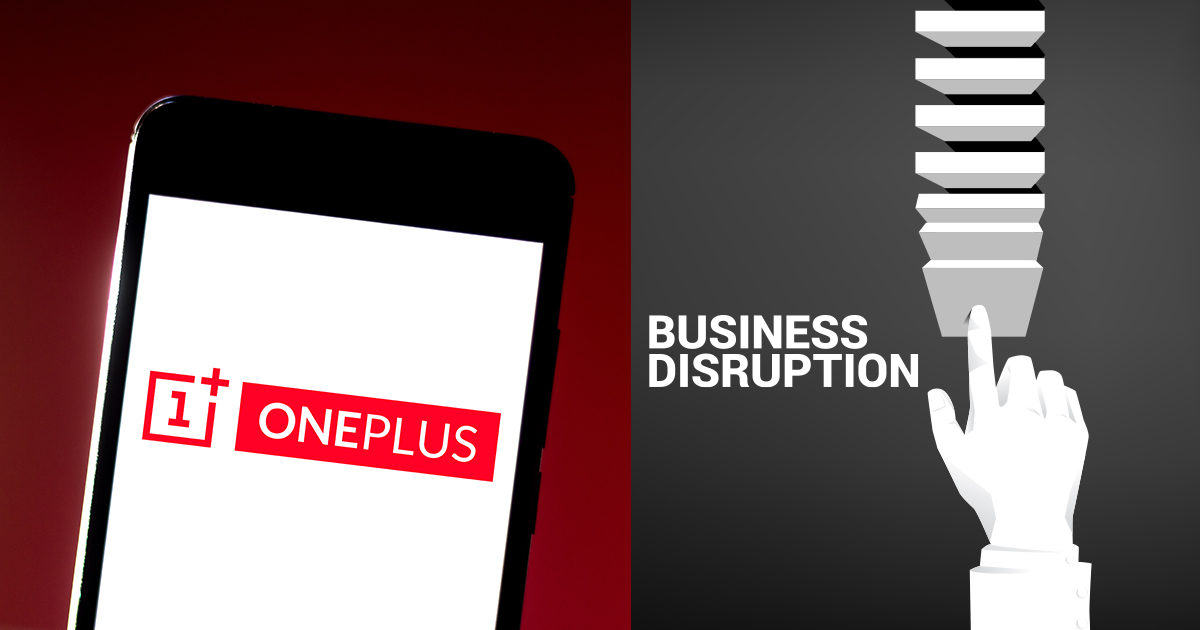Articles
How OnePlus Managed To Disrupt The Smartphone Industry

How OnePlus Managed To Disrupt The Smartphone Industry
In this digital age, where information is being exchanged at the tap of a screen or the click of a button, the need for owning a smartphone is huge. The fact that smartphones are getting cheaper, smarter and readily available makes it easy for any individual to own one.
The smartphone revolution began when Apple, under the leadership of Steve Jobs, released its first iPhone and Google developed its own open operating system (OS,) which came shipped on LG, Samsung and Sony devices. The battle for the position of best smartphone was kickstarted with people choosing either Apple or Android devices.
While Apple and Samsung are the market leaders of providing premium flagships which have the best features in terms of software and hardware, a small unknown Chinese company called OnePlus soon entered the scene. OnePlus had everything to gain with their unique marketing strategies and their unbelievable pricing without compromising on the quality of both hardware and software. Eventually, they ended up disrupting the entire smartphone industry, earning them the moniker of ‘Flagship Killer.’
Marketing strategy
OnePlus started out with the intention of providing an Android smartphone which looked and felt premium in every way. When OnePlus was beginning, Samsung was already established as a top market player with the reputation of releasing premium flagships. If OnePlus was to compete with Samsung, they needed to do something different.
OnePlus began by partnering with Cyanogen Inc., a custom ROM manufacturer for Android. Post this partnership, they got themselves published on influential websites and blogs like GSMArena and Android Authority. Once the public relations campaign was well underway and before the sale of the first OnePlus One device, the Company created an invitation only and internet only sales system. Interested buyers had to register themselves for a list which was on a first come first serve basis and the sale took place only online. This unique approach also created a buzz which was good PR. As OnePlus founder Pete Lau said in an interview with Larry Downes and Paul Nunes of Forbes, “We created the invitation system to manage uncertainty. We don’t know how many people will buy our products at any given time. Our approach helps us make an accurate sales forecast. If one phone sells for $ 200, for example, 50,000 units equals $ 10 million, 100,000 units equals $ 20 million and so on. Creating these kinds of inventories means taking on a huge financial risk. So we manage that by getting earlier insight into real customer demand through invitations.”
Identifying their geographic markets
After the success of the OnePlus One, OnePlus decided to come up with OnePlus Two and took the same approach—invite only and internet only sale. They tied up with Amazon as their exclusive selling partner in India. The demand for the smartphone was so high, they failed to keep up with the sales. OnePlus was always vocal about being in constant touch with their users on their forums in order to listen to feedback and they were surprised by the response of Indians on their forums. Currently, India is the largest market for OnePlus, contributing to up to 35 % of its revenues. The Amazon partnership worked so well, OnePlus decided to replicate it in its other markets as well by partnering with local e commerce and mobile carriers.
Perfecting the customer service experience
OnePlus remains dedicated to their motto of ‘Never Settle’ and they adopted it for their after sales services as well. They realised the need for a good customer service experience and committed themselves to opening service centers at multiple locations. In India, OnePlus is able to resolve 70 % of customers’ queries within an hour. As Vikas Agarwal, the General Manager of OnePlus India, explains, “It took us almost two years to have these centers where we guarantee to repair the device within one hour. Today, we are able to resolve 70 percent of queries within an hour. As part of enhancing the experience, two years ago, we also published the prices of our spare parts to bring in transparency.” Apart from this, they have free coffee, WiFi, XBox consoles and magazines, which elevate the customer experience. Their over the air (OTA) updates are usually continued for 3 years, which is a lot in the Android industry.
OnePlus was able to focus on developing a product which was cheap but exhibited a premium feel. It was able to provide a product for half the price at which flagship smartphones are sold. They achieved this due to their disruptive pricing, innovative marketing and good customer service. This let them capture the Indian smartphone market, which is considered as a huge revenue source by other smartphone providers, owing to the demographic dividend. Riding on their success, OnePlus also recently launched a new television, the OnePlus TV. It is likely OnePlus will ‘never settle’ and continue expanding its business.
Articles
5 Successful Indian Startups Founded By Women

The workplace has undergone massive changes in the last century. At the turn of the Industrial Revolution, any workplace was dominated by men while the women were delegated to run the homes. However, with the advent of the internet and new and exciting technologies, workplaces have undergone a tectonic shift. Women are no longer comfortable staying at home and are instead opting to lead teams and organisations. As every year passes, we get closer to true gender equality, women have proven time and again that they are equally capable to get the job done if not better in some instances. Names like Wolfe Herd (Bumble founder,) Kylie Jenner (Kylie Cosmetics founder,) Masaba Gupta (Masaba clothing label founder) are just some of the names who are known for leading world famous brands with their unique style of leadership.
As the world celebrates International Women’s Day, we bring to you five women founders who run world famous and successful startups.
1) Upasana Taku-MobiKwik
If you are an Indian and are used to doing online shopping, more often than not at the time of payment, you would be directed to a payment gateway. One of these gateways would normally be MobiKwik. The startup is a well known name in the digital payments and digital wallet space. MobiKwik was founded by Upasana Taku in 2009, who prior to founding MobiKwik used to work with PayPal. Today Upasana Taku is also in charge of bank partnerships, business operations, and talent acquisition at MobiKwik.
2) Richa Kar-Zivame
An enthusiastic MBA student, Richa Kar, developed an online lingerie shopping platform in the year 2011. Currently, Zivame is India’s leading online lingerie store with a valuation of more than $ 100 million. The brilliant idea for her own lingerie business came to light when Richa tracked Victoria’s Secret’s sales, who was one of her clients when she was working at SAP. She observed the lingerie sales figures reached peaks overseas but, Indian women were not provided with the similar innerwear. While Richa was studying the Indian lingerie market, she realized the social embarrassment in India surrounding lingerie shopping. Today Richa Kar could be credited with destigmatising the uneasiness surrounding lingerie shopping in India.
3) Falguna Nayar-Nykaa
After a long stint as an investment banker, Falguni Nayar founded Nykaa.com in the year 2013. An online one stop shop for beauty products from Indian and international brands, Nykaa changed the world of online shopping. Who would have ever thought buying makeup online would be so easy? Falguni Nayar proved many critics wrong and created a brand new place for people who love experimenting with styles, designs and colors.
ALSO READ: Zivame: Founding Story
4) Sabina Chopra-Yatra.com
Yatra.com is a popular Indian website for making flight and hotel bookings. Sabina Chopra was instrumental in identifying the potential for travel commerce in India and people moving towards cheaper or easier travel. By the time, people started looking to make bookings, Sabina made sure Yatra.com was already in place. Sabina was the former Head of India Operations of eBookers, which is also an online travel company based in Europe. Along with this, she was also working with Japan Airlines which further adds to her experience in the travel industry.
5) Rashmi Sinha-SlideShare
SlideShare allows people to upload and access their presentations online. While this feature is presently available everywhere, SlideShare was one of the first players in making this happen. Rashmi Sinha was one of the founders of the presentation sharing platform SlideShare. The company became so successful that in 2012, LinkedIn acquired the company for an amount of $100 million.
Let us know in the comments if you know any other wonderful women who have become leaders of their right or have started up and are doing extraordinary things. We at Startup Stories wish a wonderful Women’s Day to all the women in the world who are changemakers.
Articles
Why Are Ads On Digital Media Failing To Reach The Right Audience?

If you are a regular user of social media platforms and also a fan of consuming content on the digital medium, then there is a very high likelihood that you have seen ads on pages you are reading or watching something. There would be times when you have been targeted by an ad which feels like it was wrongly targeted at you. Imagine if you are a vegetarian by choice and while browsing online, if you are targeted by a food delivery app which shows ads about chicken dishes. The ad would only serve to spoil the mood of the online user instead of serving its actual purpose which is to push the user to buy a chicken dish.
These wrongly targeted ads might be the side effects of performance marketing or a weak brand marketing. Performance marketing means advertising programs where advertisers pay only when a specific action occurs. These actions can include a generated lead, a sale, a click, and more. Inshort, performance marketing is used to create highly targeted ads for a very specific target audience at a low cost. Performance marketing usually means high volume for a very specific cost.
Brand marketers on the other hand believe in narrowly defining target audiences but end up spending a lot of money on ad placements. Gautam Mehra, CEO, Dentsu Programmatic India & CDO, Dentsu International Asia Pacific said, “You’ve defined a persona, you know the emotions you want to elicit, but then you buy a YouTube masthead and CricInfo sponsorships because IPL is up. If brand advertisers look at audience-based buys more deeply than just placements, you will see more relevant ads (sic.)”
ALSO READ: How Digital Marketing Is Impacted Due To The COVID-19 Pandemic
Performance marketing is more of a sales function rather than a marketing function and is about meeting the cost of acquisition. This is a reason why budgets are usually high for performance marketing. Mehra goes on to add, “the fact is that an engineer can out-beat FMCGs on performance marketing. Advertisers who have cracked this are spending 10x and are on an ‘always on’ mode (unlike time-bound brand campaigns.)”
There is always the case of supply and demand, with the supply usually exceeding the demand on digital platforms. Ultimately, it boils down to the choice between no ad versus low relevance ad and it is quite easy to guess that having a low relevance ad is better.
Arvind R. P., Director – Marketing and Communications at McDonald’s India (West and South,) said “McDonalds’ for instance, has seen its share of spends on digital grow from 20% levels a couple of years back to over 40% at present. Outcomes of this journey have been encouraging, proven by our media-mix-modelling and other key metrics. We have seen best results from an optimal mix of Television plus digital (sic.)” Moreover, Arvind also believes performance marketing only approach could turn out to be more suited to short term, versus a more consistent full funnel effort. The latter ensures adequate emphasis on building consideration, as well as growing transactions. Arvind feels digital is a complex medium which needs investment in the right talent who could use the right tools. Brands which underestimate the need for the investment are often disappointed from the return on investment from the digital medium.
With the constantly changing consumer dynamics marketers are now shifting to unscripted marketing which frankly needs more insights into the consumer mindset. The lack of marketers to do the proper research is why digital medium is plagued with irrelevant ads.
Articles
From Unicorn To Bankruptcy; Knotel Bears The Brunt Of COVID-19 Pandemic

It is no secret that in the fast paced world of startups, fortunes can change at the snap of fingers. Sometimes startups tend to scale so quickly that they become unicorns and sometimes the fortunes reverse so quickly that a startup can immediately go bankrupt from being a unicorn. The latter was the case for an American property technology startup Knotel, who are now bankrupt due to the disruptions by the COVID-19 pandemic.
Knotel is a property technology company quite similar to WeWork. Knotel designed, built and ran custom headquarters for companies which It manages the spaces with ‘flexible’ terms. Knotel does a mix of direct leases and revenue sharing deals. Knotel marketed its offering as ‘headquarters as a service’ or a flexible office space which could be customized for each tenant while also growing or shrinking as needed. For the revenue-share agreements, Knotel solicits clients, builds out offices, and manages properties, and shares the rent paid to it by the client with the landlord. This model is the majority revenue generator for Knotel.
In March 2020, just before the COVID-19 pandemic unleashed its economic destruction on the world, Knotel was valued at $ 1.6 billion. What is even more interesting is Knotel raised $ 400 million in Series C funding in August 2019 which led to its unicorn status. However, with the COVId-19 pandemic and its consequent lockdowns and curfews by various governments across the world, startups and businesses shifted to a remote working model. This in turn led to startups pulling out of Knotel properties to cut down on working costs.
ALSO READ: Quibi : Startup With A Billion Dollar Launch To Shutting Down All In Six Months
In late March 2020, according to Forbes, Knotel laid off 30% of its workforce and furloughed another 20%, due to the impact of the coronavirus. It was at this point that Knotel was valued at $ 1.6 billion. The company had started the year with about 500 employees. By the third week of March,Knotel had a headcount of 400. With the cuts, about 200 employees remained with the other 200 having either lost their jobs or on unpaid leave, according to Forbes.
In 2021, Knotel filed for bankruptcy and agreed to sell its assets to Newmark, one of their investors for a total of $ 70 million dollars. As work culture is still undergoing changes as a consequence of the COVID-19 pandemic and with many companies realising that remote work model saves costs and improves work efficiency, the flexible workspace sector would continue to face challenges. Knotel is just the tip of the iceberg and is a warning call for the flexible working spaces industry.















Kuwin
November 5, 2025 at 2:40 pm
kuwin sở hữu kho game đa dạng từ slot đến trò chơi bài đổi thưởng, mang đến cho bạn những giây phút giải trí tuyệt vời.
谷歌外推
November 10, 2025 at 6:50 am
采用高效谷歌外推策略,快速提升网站在搜索引擎中的可见性与权重。谷歌外推
MM88
November 10, 2025 at 7:54 pm
Với giao diện mượt mà và ưu đãi hấp dẫn, MM88 là lựa chọn lý tưởng cho các tín đồ giải trí trực tuyến.
ios超级签
November 12, 2025 at 6:01 pm
苹果签名,苹果超级签平台,ios超级签平台ios超级签苹果企业签,苹果超级签,稳定超级签名
GO88
November 13, 2025 at 11:09 pm
Tham gia cộng đồng game thủ tại Go88 để trải nghiệm các trò chơi bài, poker phổ biến nhất hiện nay.
iwin
November 18, 2025 at 11:43 pm
iwin – nền tảng game bài đổi thưởng uy tín, nơi bạn có thể thử vận may và tận hưởng nhiều tựa game hấp
J88
November 20, 2025 at 9:55 am
Đến với J88, bạn sẽ được trải nghiệm dịch vụ cá cược chuyên nghiệp cùng hàng ngàn sự kiện khuyến mãi độc quyền.
MM88
November 29, 2025 at 3:15 pm
Khám phá thế giới giải trí trực tuyến đỉnh cao tại MM88, nơi mang đến những trải nghiệm cá cược thể thao và casino sống động.
online Gambling
December 19, 2025 at 7:12 am
online Gambling online Gambling
Exklusive Playfina Vorteile
December 20, 2025 at 6:55 pm
Wir zeigen dir, wie du gratis Spielautomaten spielen kannst.
Mittlerweile gibt es auch online so viele Slots, dass es kaum möglich ist,
diese alle mit echtem Geld zu spielen. Trotzdem kann man sagen, dass man kostenlos
um Geld spielen kann… und diese Chance sollte man sich nicht entgehen lassen! Die muss
man erstmal knacken, um seinen Echtgeldgewinn ohne Einsatz zu
erspielen!
Wenn Sie Automatenspiele kostenlos ohne Anmeldung spielen,
müssen Sie auf nichts verzichten. Wenn Sie die
Casino Automatenspiele des Anbieters kostenlos
spielen, erwarten Sie mehrere Bonusfunktionen und
eine moderne Grafik. Natürlich können Sie ebenfalls bei uns Megaways Slots kostenlos
spielen. Aufgrund der großen Auswahl lohnt
es sich, Automatenspiele kostenlos zu spielen.
Starte einfach den Gratis-Download und spiele
alle Slots und Casino Spiele auch auf Deinem Handy. Du zockst im Online-Casino auch
so lange anonym kostenlose Spiele, wie Du es für richtig hältst.
Diese Spiele schützen dabei aber Dein Geld, denn
kostenlose Spiele kosten natürlich nichts. Nutze die Gratis-Spiele und
genieße kostenlose Casino-Spiele, solange Du Lust am Spielen hast.
References:
https://online-spielhallen.de/ihr-ultimativer-leitfaden-zum-tipico-casino-promo-code-so-holen-sie-das-maximum-heraus/
paypal casino sites
December 27, 2025 at 12:41 am
Notable bonus features include welcome deals, complimentary spins, cashback rewards, and contests featuring significant prize
pools. Skycrown cares about the safety of its users, so it uses two-factor
authentication (2FA), which can be activated in the account settings.
The platform allows you to log in from any device – a computer, tablet or smartphone.
Login to your account is organized as conveniently and securely as possible.
Go to the main page of the casino and click the registration button in the upper right corner.2.
From pokies to sports betting, everything you need
is just a click away. Our commitment to transparency and trust ensures you can focus on enjoying your experience.
With SkyCrown, your sports betting experience is seamless,
secure, and packed with opportunities. No matter
your gaming preference, SkyCrown Casino Online has something to thrill and entertain. Recognising
the signs of problem gambling early is crucial—loss of control, constant chasing of wins, or neglecting daily life are all warning signals.
Overplaying or treating it as an income source can harm your finances,
relationships, and wellbeing.
References:
https://blackcoin.co/bars-the-classic-slot-machine-theme/
Canberra entertainment options
December 27, 2025 at 1:01 pm
Click the comment button to sign-in or sign-up.
If you don’t have Sky Cinema and want to get Paramount+, you’ll
need to sign-up on your Sky Q, Glass or Stream by
following the instructions here. If you have Sky Cinema, you
can now sign up to Paramount+ at no extra
cost by signing in to My Sky. You might notice this change on your account from 16 January.
The SerpApi Model Context Protocol (MCP) server provides a unified search tool for AI agents.
It’s also worth taking a look at our Bing Playground and performing a few searches to see it all in action. Returned in the
relatedSearches.value key (array of related searches) in the official API, our API returns the equivalent in the top
level related_searches key (array of related searches).
References:
https://blackcoin.co/10-minimum-deposit-casino-bonuses-in-australia-2025-guide/
https://jobs.maanas.in/institution/paypal-payment-casinos-2025-canada-choose-your-paypal-casino
December 29, 2025 at 1:07 pm
online casino for us players paypal
References:
https://jobs.maanas.in/institution/paypal-payment-casinos-2025-canada-choose-your-paypal-casino
https://www.paknaukri.pk/companies/online-casino-mit-paypal-einzahlung-die-top-casinos-im-vergleich/
December 29, 2025 at 1:21 pm
online pokies australia paypal
References:
https://www.paknaukri.pk/companies/online-casino-mit-paypal-einzahlung-die-top-casinos-im-vergleich/